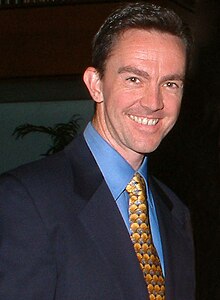J. Davy Kirkpatrick
J. Davy Kirkpatrick | |
|---|---|
 | |
| Born | July 28, 1964 |
| Known for | Brown dwarfs, Low-mass stars, Stellar spectral classification |
| Scientific career | |
| Fields | Astronomy |
| Institutions | California Institute of Technology |
J. Davy Kirkpatrick is an American astronomer at the Infrared Processing and Analysis Center at the California Institute of Technology in Pasadena, California. Kirkpatrick's research was named one of the top ten science accomplishments of the first ten years (1992–2002) of the W. M. Keck Observatory[1] and one of the Top 100 Stories of 2011 by Discover Magazine.[2]
Career
Education
Kirkpatrick received a BS in mathematics and physics/astronomy from Vanderbilt University in 1986 and a PhD in astronomy from the University of Arizona in 1992. He was a W. J. McDonald Fellow at the University of Texas at Austin from 1992-1994, a National Research Council Fellow at JPL from 1994-1996, and a NICMOS Fellow at UCLA from 1996-1997 before being hired at Caltech, where he works today.[verification needed]
Brown Dwarfs and Low-mass Stars
Much of Kirkpatrick's research has concentrated on the discovery and characterization of the lowest mass stars and brown dwarfs. After refining the far optical and near-infrared classifications[3] of M dwarfs in the early 1990s and publishing the first spectrum of the brown dwarf candidate GD 165B, which would later be referred to as the first L dwarf discovery, Kirkpatrick joined the Two Micron All-Sky Survey[4] (2MASS) team to search for even colder objects. Along with Neill Reid, he uncovered many objects similar to and colder than GD 165B, leading to the definition of the L dwarf[5] spectral class. Also using 2MASS data, he and graduate student Adam Burgasser discovered brown dwarfs even colder than spectral class L, leading to the establishment of the T dwarf[6][7] spectral class. More recently, as a member of the Wide-field Infrared Survey Explorer (WISE)[8] team, Kirkpatrick and his research group have uncovered even colder brown dwarfs,[9] leading to the establishment, with postdoc Michael Cushing, of the Y dwarf[10] spectral class.
Along with Adam Burgasser and Chris Gelino, Kirkpatrick maintains a listing of all known L, T, and Y dwarf discoveries at the DwarfArchives[11] website.
Tyche
Kirkpatrick is credited with first using the name "Tyche" to refer to a heretofore unseen, low-mass Solar companion in the Oort Cloud. He chose this term to be in direct contrast[12] to "Nemesis", an unseen Solar companion hypothesized to lie in a highly elliptical orbit and to be responsible for periodic mass extinctions on the Earth. Kirkpatrick's own search using the 2MASS data set rules out any Solar companion more massive than 30 Jupiter masses,[13] although analysis of the WISE data set should set much more stringent limits.[14]
Selected publications
- "New Spectral Types L and T" from Annual Review of Astronomy and Astrophysics, 2005[15]
- "M Dwarfs and L Dwarfs", Chapter 9 of Stellar Spectral Classification[16]
Awards and honors
- 2011 Wendell G. Holladay Lectureship [17]
- 2010 Marc Aaronson Memorial Lectureship[18]
- 2003 Watkins Visiting Professorship,[19] Wichita State University
- 1986 Underwood Award, Vanderbilt University Department of Physics and Astronomy
References
- ^ "New Kinds of Stars" (PDF).
- ^ "Found: Stars Cool Enough to Touch".
- ^ "A standard stellar spectral sequence in the red/near-infrared — Classes K5 to M9". Bibcode:1991ApJS...77..417K.
{{cite web}}: Missing or empty|url=(help) - ^ "The Two Micron All Sky Survey (2MASS)". Bibcode:2006AJ....131.1163S.
{{cite web}}: Missing or empty|url=(help) - ^ "Dwarfs Cooler than "M": The Definition of Spectral Type "L" Using Discoveries from the 2 Micron All-Sky Survey (2MASS)". Bibcode:1999ApJ...519..802K.
{{cite web}}: Missing or empty|url=(help) - ^ "The Spectra of T Dwarfs. I. Near-Infrared Data and Spectral Classification". Bibcode:2002ApJ...564..421B.
{{cite web}}: Missing or empty|url=(help) - ^ "A Unified Near-Infrared Spectral Classification Scheme for T Dwarfs". Bibcode:2006ApJ...637.1067B.
{{cite web}}: Missing or empty|url=(help) - ^ "The Wide-field Infrared Survey Explorer (WISE): Mission Description and Initial On-orbit Performance". Bibcode:2010AJ....140.1868W.
{{cite web}}: Missing or empty|url=(help) - ^ "The First Hundred Brown Dwarfs Discovered by the Wide-field Infrared Survey Explorer (WISE)". Bibcode:2011ApJS..197...19K.
{{cite web}}: Missing or empty|url=(help) - ^ "The Discovery of Y Dwarfs using Data from the Wide-field Infrared Survey Explorer (WISE)". Bibcode:2011ApJ...743...50C.
{{cite web}}: Missing or empty|url=(help) - ^ "DwarfArchives.org".
- ^ "Mystery Planet: Is a Rogue Giant Orbiting Our Sun?". Time. 16 February 2011.
- ^ "Dark Threat, Astronomy Magazine, July 2005, p. 40".
- ^ "Can WISE Find the Hypothetical "Tyche"?".
- ^ Kirkpatrick, J. Davy (2005). "New Spectral Types L and T". Annual Review of Astronomy & Astrophysics. 43: 195. Bibcode:2005ARA&A..43..195K. doi:10.1146/annurev.astro.42.053102.134017.
- ^ Stellar Spectral Classification Richard O. Gray and Christopher J. Corbally, 2009, Princeton University Press. ISBN 978-0-691-12511-4
- ^ "Vanderbilt Physics and Astronomy Colloquium, 2011-2012". Archived from the original on 2012-07-03. Retrieved 2012-02-06.
- ^ "The Secret Lives of Brown Dwarfs: Hidden Oddballs of the Universe".
- ^ "Watkins Visiting Professorship scientific lecture".
External links
- Radio SETI interview, Fall 2011, entitled "You've Got Sol!"
- News report, August 2011, entitled "NASA WISE Mission Uncovers Stars Cooler Than The Human Body"
- Podcast of Keck Public Lecture, October 2006, entitled "Brown Dwarfs: Bridging the Gap Between Stars and Planets"
- "Ask an Astronomer" video from 2003 entitled "What is a Brown Dwarf?"
